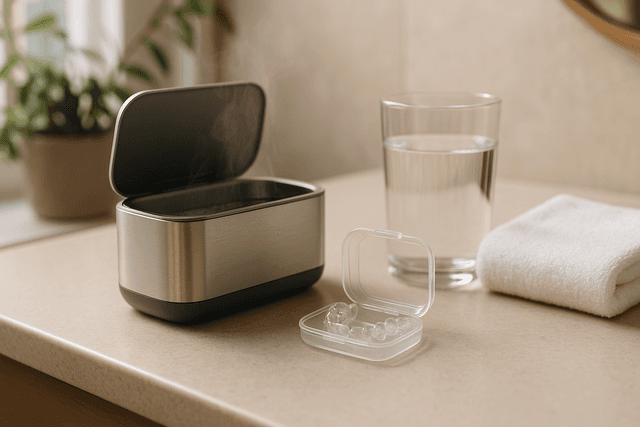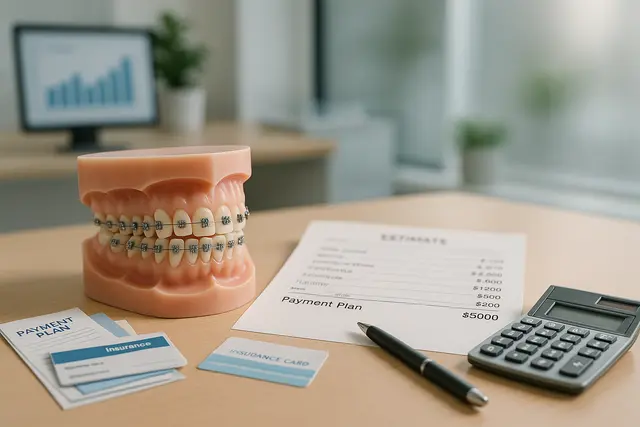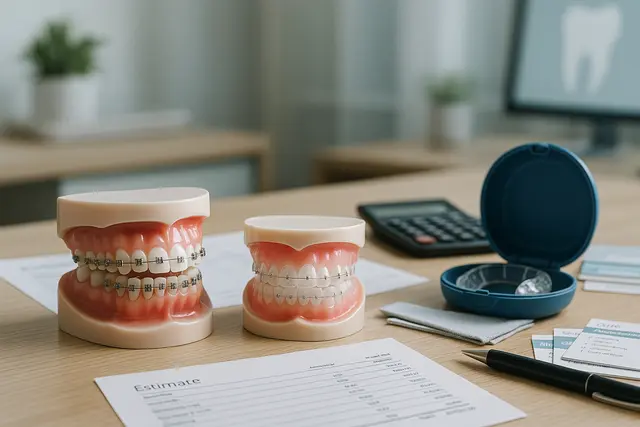Orthodontics
5 min read
Aug 12, 2025
Best At Home Retainer Cleaner Options for a Brilliant Smile
Keeping your retainer clean isn’t just about appearance, it’s essential for protecting your oral health. A well-maintained retainer prevents bacteria buildup, keeps your breath fresh, and ensures your smile stays aligned after orthodontic treatment. With the right tools and habits, you can keep it spotless from the comfort of home.

If you’ve ever pulled your retainer out of its case, taken one look, and thought “Oh no…”, you’re not alone. Retainers work hard to keep your smile in line, but they also collect a fair share of plaque, bacteria, and the occasional mystery speck from your bag or pocket. The good news? Keeping your retainer clean at home is totally doable with the right tools and habits.
Let’s talk about the best ways to get that retainer sparkling, fresh, and ready for action.
Retainer Care Matters More Than You Think
Your retainer is not just a piece of plastic or wire. It’s a dental appliance that lives in close contact with your teeth, gums, and mouth. That means bacteria on your retainer can easily stick to your teeth and become a breeding ground for bacteria and plaque. Left alone, that buildup can lead to tartar, bad breath, and even irritation. If you’ve had orthodontic treatment, you don’t want to risk undoing all that time and investment just because your retainer doesn’t get cleaned enough.
The easiest way to keep your retainer clean is to make it part of your regular cleaning routine. Think of it like brushing your teeth: quick daily care plus a deeper clean every so often.
Simple Ways to Clean Your Retainer Every Day
The best way to clean your retainer daily is to rinse your retainer right after you take it out. Lukewarm water works well, since hot or boiling water can warp the shape and damage your retainer. Use a soft toothbrush to gently clean around all surfaces. Skip harsh chemicals or whitening toothpaste, which can scratch the surface.
If you wear your retainer overnight, bacteria and plaque can start to form while you sleep. A quick rinse in the morning followed by a gentle scrub will keep your retainer fresh until it’s time to put it back in. Don’t forget to rinse the retainer case too, because it can hold bacteria just like the retainer itself.
When You Want to Clean Your Retainer More Thoroughly
Sometimes, water alone won’t cut it. Plaque and buildup can stick to your retainer in ways brushing won’t remove. That’s when you’ll want a deeper cleaning method. Popular options include:
Retainer Cleaner Tablets: Drop one tablet into a glass of water, submerge your retainer, and let it fizz away. These effervescent tablets break down debris without damaging your retainer. For great results, see the Best Denture Soaking Solution guide.
Baking Soda: Make a simple baking soda paste with water to gently scrub your retainer, or add baking soda to water for a soak.
White Vinegar: Mix white vinegar with water to make a mild cleaning solution. Soak your retainer for about 15 minutes, then rinse thoroughly.
The Power of Ultrasonic Cleaning
If you want to get serious about cleaning, consider an ultrasonic cleaner for your retainer. This gadget uses sound waves to shake loose tiny particles and bacteria from your retainer’s surface. An ultrasonic retainer cleaner is a great way to clean retainers without scrubbing. You can pair it with a cleaning solution specifically for oral appliances for even better results.
An ultrasonic retainer is not just for retainers. It can be used to clean dental retainers, clear aligners, dentures, and even mouthguards. Think of it as a spa day for your dental appliance.
Fighting Plaque and Buildup Before It Wins
Plaque loves a surface it can stick to, and your retainer is no exception. The longer plaque sits, the harder it is to remove. If you notice buildup, you can soak your retainer in distilled water with a cleaning tablet or use a mild hydrogen peroxide mix for extra cleaning power. Just be sure to rinse your retainer thoroughly afterward to avoid any lingering taste.
Some people find that a quick rinse in Mouthwash helps keep their retainer smelling fresh. Just be sure your mouthwash is alcohol-free, so it doesn’t damage your retainer.
Special Care for Different Types of Retainers
Clear retainers and plastic retainers need gentle cleaning methods since abrasive products can scratch them. Invisalign retainers and other clear aligners also fall into this category. Permanent retainers, on the other hand, are fixed to your teeth and require careful brushing and flossing to remove plaque. Your dentist or orthodontic provider can show you the best way to clean around them.
If you have a retainer without any metal parts, soaking in cleaning products made for dentures or retainers can work well. If you’re unsure, always check with your dentist before trying a new method.
The Right Cleaning Products Make a Difference
There’s no shortage of cleaning products out there claiming to be the best cleaning solution for retainers. The key is to choose something safe, effective, and easy to use. Effervescent tablets are popular for their convenience, while ultrasonic cleaners win points for high-tech effectiveness. Baking soda paste is a tried-and-true method you can whip up anytime.
Whatever you choose, make sure it’s used to clean appliances that go in your mouth. Avoid anything with bleach or harsh chemicals, and never use boiling water. That’s the fastest way to damage your retainer.
Tips for Keeping Your Retainer Clean Long Term
Make cleaning your retainer a habit.
Place your retainer in a clean retainer case when not in use.
Rinse your retainer before and after wearing it.
Soak your retainer in distilled water occasionally to keep it from drying out.
For deeper cleaning, use retainer cleaner tablets once or twice a week.
If you ever notice allergic reactions, odd tastes, or visible damage, stop using the product and check with your dentist. Sometimes buildup or tartar will need professional cleaning to fully remove plaque.
Why Your Dentist Should Still Check Your Retainer
Even if you have the best way to clean your retainer at home, your dentist should still take a look during checkups. They can spot early signs of wear, bacteria on your retainer, or damage your retainer might have taken over time. Plus, they can recommend cleaning methods tailored to your specific orthodontic treatment.
What Is the Best Way to Clean a Retainer at Home?
The best way to clean a retainer at home is to rinse it with lukewarm water immediately after removing it, then gently brush it with a soft toothbrush and a mild, non-abrasive cleaner designed for oral appliances. Avoid using hot or boiling water, as it can warp the retainer. For deeper cleaning, use retainer cleaning tablets, a baking soda paste, or a white vinegar and water solution, making sure to rinse thoroughly before wearing it again.
Are Ultrasonic Retainer Cleaners Effective?
Yes, ultrasonic retainer cleaners are highly effective for deep cleaning without the need for scrubbing. They use sound waves to loosen plaque, bacteria, and debris, reaching areas that are difficult to clean manually. These devices work well for different types of dental appliances, including clear aligners, dentures, and mouthguards. For best results, pair the ultrasonic cleaner with a cleaning solution made specifically for oral appliances.
Can I Use Household Items to Clean My Retainer?
Yes, certain household items can be safe and effective for cleaning retainers. Baking soda can be made into a paste for gentle scrubbing, or added to water for soaking. A diluted white vinegar solution can help remove stains and bacteria, while mild hydrogen peroxide can be used occasionally for disinfecting. Always rinse thoroughly afterward, and avoid using bleach, alcohol-based products, or abrasive toothpaste, which can damage the retainer.
How Can I Prevent Plaque and Odor on My Retainer?
To prevent plaque buildup and odor, clean your retainer daily and store it in a clean, dry case when not in use. Rinse it before and after wearing, and soak it in distilled water or a cleaning solution once or twice a week for extra freshness. Regularly cleaning your retainer case is also important, as bacteria can transfer from the case back onto the appliance. For permanent retainers, use floss threaders or interdental brushes to keep the surrounding teeth and wires clean
Read Next
Related Posts

Orthodontics
How Much Are Metal Braces? Cost Comparison With Other Options
Thinking about getting braces but overwhelmed by the cost? You’re not alone. Orthodontic treatment can be a major investment, and understanding the different price points, from metal braces to clear aligners, can help you make a smart, confident decision.
5 min read
Sep 15, 2025

Orthodontics
Retainer That Looks like Braces: Benefits for Long-Term Alignment
A retainer might not get as much attention as braces, but it plays a crucial role in maintaining your smile after orthodontic treatment. Whether you're new to retainers or curious about the type that looks like braces, understanding their purpose and benefits is key to keeping your teeth aligned for the long haul.
6 min read
Sep 15, 2025

Orthodontics
Orthodontics & Braces Statistics (Adults + Kids)
Orthodontics has transformed from a niche medical service for teenagers into a booming sector that spans all ages. Today, both adults and children seek orthodontic treatment to improve their smiles, fix bite issues, and boost self-confidence.
4 min read
Aug 21, 2025
Don’t have time to research every dentist around you?
See why 30k+ patients trusted us